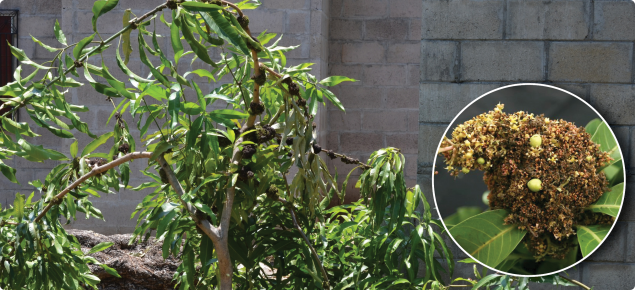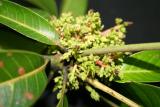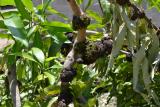What plants are affected?
- Mango malformation disease only infects mango trees.
What do I look for?
- Flowers and shoots develop abnormally with stunted, compact growth.
- Shoots are tightly bunched and misshapen with shortened internodes.
- Flower stems are shortened, thickened and highly branched with 2-3 times more flowers than normal.
- Leaves sometimes grow in the flower head.
How does the disease survive and spread?
- The fungus infects emerging flower and shoot buds, then fungal spores are produced on infected plant parts.
- Spread within orchards is slow. Spores can be spread by contaminated pruning equipment, air currents, rain splash and infected plant material falling from infected trees. Mango bud mite (Aceria mangiferae) is thought to assist spread of the disease within orchards.
- Mango malformation spreads longer distances with nursery stock and budwood.
- The disease is not spread in fruit or seeds.
- The disease can remain dormant for several years before showing symptoms.
What damage can this disease cause?
- Affected flowers do not usually set fruit, which reduces yield.
- Abnormal growth can stunt mango trees.
Status in Western Australia
Fusarium mangiferae is absent from Western Australia and is a quarantine pest. It is a prohibited organism under section 12 of the Biosecurity and Agriculture Management Act 2007.
Western Australia's Pest Freedom for mango malformation disease is supported by general and targeted surveillance, and by specific import requirements to prevent its entry. A person who finds or suspects the presence of mango malformation disease must report it to DPIRD.
What do I do if I find it?
It is important that any suspect mango malformation disease occurrence is reported. Early detection and eradication will help protect Western Australian mango growers. If you find or suspect plants with mango malformation disease, please make a report using MyPestGuide® Reporter or contact the Pest and Disease Information Service (PaDIS) to report this pest.
 | MyPestGuide® Reporter Pest and Disease Information Service |



